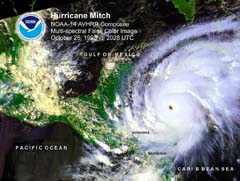|
NOAA PROVIDES CENTRAL AMERICA LIFE SAVING SATELLITE WEATHER TECHNOLOGY
On July 26, the United States will transfer to Costa Rica a satellite ground station that will bring high resolution digital imagery from NOAA's Geostationary Operational Environmental Satellites to the Central American region. This system will allow weather forecasters in the region to perform quantitative analysis of the data, which will lead to enhanced forecasting. From a hub in San Jose, Costa Rica, the data will be distributed to meteorological services in Belize, El Salvador, Honduras, Guatemala, Nicaragua, and Panama. "NOAA is proud to be a part of this multinational effort," said Gregory Withee, assistant administrator for NOAA satellite and information services. "Working with the U.S. Agency for International Development and with the nations of Central America, we are able to provide the satellite technology that will improve weather forecasts and warnings and save lives in the region." This new system builds on NOAA's existing partnership with other nations in the Atlantic, Caribbean, and Central American region by employing the latest in satellite meteorological technology to improve hurricane warning systems and programs. In bringing this about, SICA (Sistema de Integracion Centroamericana), a presidential-level regional coordinating body located in San Salvador, El Salvador, and the Comite Regional de Recursos Hidráulicos (CRRH), a regional meteorological and hydrological organization, provided critical regional coordination with Central American governments. "We are pleased to receive this capability that will greatly enhance our ability to provide more accurate and timely warnings to protect life, property, and our growing economies," said Eladio Zarate, director of the Instituto Meteorologico Nacional (IMN) in San Jose. "Costa Rica is proud to have been selected as the regional hub from which these critical satellite data will be provided to the region. We are particularly pleased that our Science and Technology Ministry has recently upgraded our Internet connectivity to allow us to share the data with other countries in the region." Based on technical assessments conducted by NOAA, and consultations with the national meteorological services of the Central American countries and with CRRH, a determination was made that the region needed access to higher resolution meteorological data to support better and more accurate weather forecasts and hurricane threats. As a result of these recommendations, each national meteorological office will be equipped with special computers that will allow them to detect hurricanes, heavy precipitation, wildland fires, volcanic ash movement, and cloud movement with new data available every 30 minutes. Through an international partnership, NOAA's National Environmental Satellite, Data and Information Service worked with Global Imaging, of Solana Beach, Calif., to install the GOES satellite data receive station. In addition, Colorado State University's Cooperative Institute for Research in the Atmosphere in Fort Collins, Colo., and the University of Wisconsin's Cooperative Institute for Meteorological Satellite Studies in Madison, Wis., developed and implemented systems architecture and training programs for meteorologists from the Central American region to help them take advantage of the new technology. NESDIS is the nation's primary source of space-based meteorological and climate data. NESDIS operates the nation's environmental satellites, which are used for weather forecasting, climate monitoring, and other environmental applications such as fire detection, ozone monitoring, and sea surface temperature measurements. NESDIS also operates three data centers, which house global data bases in climatology, oceanography, solid earth geophysics, marine geology and geophysics, solar-terrestrial physics, and paleoclimatology. Relevant Web Sites
|
